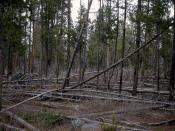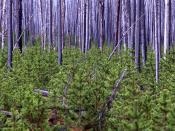Introduction
The importance of fire as a keystone process in northern Rocky Mountain forests is widely recognized (e.g., Habeck and Mutch 1973; Wright and Heinselman 1973; Arno 1980; Wadleigh and Jenkins 1996; Barrett et al. 1997; Murray et al. 1998). At a landscape scale, periodic fire partitions the landscape into patches of forest at various stages of recovery providing a diverse array of habitats (Romme 1982; Turner et al. 1994; Turner and Romme 1994; Turner et al. 1997; Wright and Hayward 1998). Fire impacts forests at local scales by modifying stand structure and composition, and altering fuel characteristics. Fire has also served an important evolutionary purpose. Species adaptations such as thick, insulating bark enable species such as ponderosa pine (Pinus ponderosa Laws.) to survive periodic fires, and the development of serotinous cones like those often found on lodgepole pine (Pinus contorta ex Dougl.) that ensure rapid establishment following fire events (Heinselman 1981).
Although fire has played a vital role in structuring and organizing forests, the feedbacks and interactions among fire, climate, and vegetation vary at different spatial and temporal scales. At long time scales (century-to-millenial) and across broad regions (e.g., 106 ha) climate governs vegetation composition and distribution (Delcourt and Delcourt 1987) and alters the fire regime (i.e., fire frequency, extent, and severity) (Swetnam 1993). Fire in turn modifies the vegetation mosaic at these scales through the creation of a landscape with areas in various successional states. At smaller/shorter spatiotemporal scales climate alters fuel properties through short-term weather events, and influences fire through the creation of favorable conditions for ignition and spread. In addition, characteristics of the fire regime, such as severity and frequency, further modify fuel properties. Stand-replacing fires may consume most of the available fine fuel, but leave standing dead timber that augments fuel loadings in the...


